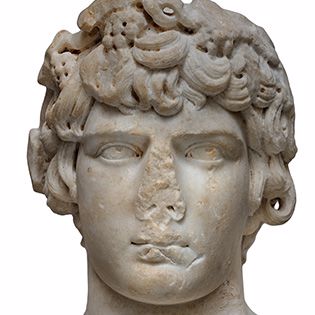Antinous and the Lerna mysteries: A marble statue from the sanctuary of Demeter Prosymna and Dionysus
- Location
- Arts Lecture Room 201
- Dates
- Tuesday 28 February 2017 (16:00-17:00)
 Head of a marble statue of Antinous/Dionysus from Lerna/Argolis, 130-138 CE. Argos, Archaeological Museum
Head of a marble statue of Antinous/Dionysus from Lerna/Argolis, 130-138 CE. Argos, Archaeological Museum
Professor Theodosia Stefanidou-Tiveriou (Aristotle University of Thessaloniki)
This event is co-sponsored by the Birmingham Research Institute in History and Cultures (BRIHC) and the Birmingham and Midlands Classical Association
Abstract
The marble statue from Lerna in the Argolid, which is the focus of this lecture, can be readily recognized as Antinous because of the portrait type of the head, which is the so-called main type (Haupttypus) of Antinous’s portraits. The statue itself belongs to a group of other statues of Antinous, which have common characteristics without being faithful copies of one another: they are naked and have a severe posture with the right leg bending forward and sideways, while the whole of the foot rests flat on the ground. These statues are probably classicizing creations of Hadrian’s time going back to works of the Severe style (i.e. of the fifth century BCE).
The deification and cult of Antinous promoted by Hadrian were part of the emperor’s broad strategy to ensure the internal cohesion of the empire. After his mysterious death by drowning in the Nile in 130 CE, Hadrian’s young companion from Bithynion/Asia Minor was automatically identified with Osiris. Outside Egypt, in the Roman Empire and especially in the Eastern Provinces Antinous was frequently equated with the Hellenic equivalent of Osiris, the god Dionysus. His cult was introduced to important centres of ancient cults and the new god (or hero) could be interpreted in various ways, so as to ensure the cult’s integration in any given religious context.
In ancient Lerna, Antinous’ cult was accepted in the existing sanctuary of Demeter Prosymna and Dionysus, who were worshipped with mystery rituals according to Pausanias. In 1986, an over-life-sized marble statue of Antinous wearing an ivy wreath and holding probably a thyrsus and a torch was discovered within a complex of buildings, which has been identified as part of the precinct of Demeter Prosymna and Dionysus. The base of a second bronze statue bearing a votive inscription to Antinous was also found during the excavation. Several reasons make the choice of Lerna exceptionally well-suited for introducing the new cult: a) the tradition for the arrival of Danaos and his daughters from Egypt and the introduction of several cults in Lerna from there; b) the traditions about Dionysus’s descent into the Underworld through the Alkyonian Lake and his emergence from the waters of the lake—the correspondence between the Argive tradition and the drowning of Antinous in the waters of the Nile and his deification is apparent; and c) the relationship between the Lerna mysteries and the Eleusinian mysteries. The torches would have played an important part in the nocturnal ceremonies of Lerna just as in Eleusis. Antinous himself had a direct relationship with Eleusis, as he probably visited Eleusis with Hadrian and Sabina in 128 CE and was initiated into the mysteries. As is well known, the Antinoeia were celebrated there too.
The statue that we are discussing shows the new god of the sanctuary of Dionysus and Demeter at Lerna with Dionysiac symbols, i.e. ivy wreath and thyrsus, and at the same time holding a torch—an object that played part in the mystery cults of both Dionysus and Demeter. In this way, Antinous holding a torch appears both as a new god and as an initiate in the mysteries.
The extraordinary and probably successful integration of the cult of Antinous to the preexisting cults of Lerna and their mythological framework sheds light on the significance of the new god in Hadrian’s time and until the 3rd c. CE. Whereas special emphasis has been placed on the political characteristics of the cult, supported by the absence of special theological concepts connected exclusively with Antinous, the evidence from the sanctuary of Demeter Prosymna and Dionysus strongly supports the idea that the new cult succeeded—at least in certain instances—to acquire the character of a cult accepted in fairly wide circles.
Visual culture in Rome’s provinces
The Classical Archaeology Seminar of the Department of Classics, Ancient History and Archaeology in Spring Term 2017 is on Visual culture in Rome’s Provinces. Young researchers and prominent international scholars will present papers on the multilayered and astonishingly heterogeneous in character visual culture in Rome’s Provinces, addressing local and regional diversity as well as the distinct cultural environments that affected artistic production.
Seminars take place on Tuesdays at 16:00 and are located either in the Arts Building (Room 201) or in Strathcona Building (Lecture Theatre 6) on the North campus of the University. All are most welcome to attend. Papers typically last 50 minutes and are followed by questions and discussion over refreshments, and there is often an opportunity to join the speaker later over dinner.